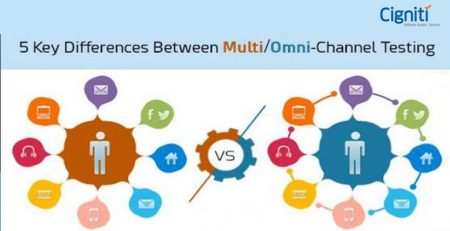3 Reasons Why You Need to Involve Omnichannel in Your Ecommerce Strategy
There are over 2 billion smart phone users in the world and about 56% of the world’s population has access to the internet. More than 21% of the shoppers make their purchases online. In the first quarter itself of 2019, consumers have spent over $22 Billion on mobile applications. All these statistics show that the world is becoming a digitally-connected ecosystem, driving the need for solutions that will further fuel its growth.
Ecommerce is becoming mainstream, and brick-and-mortar stores are going out of the picture. Or so everyone thought. The rise in the ecommerce sales has been attributed to be the reason for decline of physical retail stores. In reality, the reason for their decline is the inability of the traditional retailers to adapt and change with the evolving trends.
A buyer’s journey in the modern era involves a variety of technology-driven check points. With more resources at their disposal, modern buyers prefer to make an informed decision over relying simply on their gut.
Omnichannel ecommerce is all about offering a seamlessly stitched shopping experience to the customers. In this digitally intertwined ecosystem, omnichannel makes it possible to deliver a unified, integrated, and tailored shopping experience to the customers by syncing all the touch points involved in a buyer’s lifecycle. Omnichannel commerce is centrally driven by the requirement to offer the best experience to their customers and elongating a buyer’s lifecycle through optimum retention tactics.
On an average, a customer interacts and engages with a retailer through 5 different touchpoints, including both online and offline platforms. An ecommerce provider must ensure that all these touch points are effectively covered, in order to not create an inconvenient break in an otherwise smooth buying journey. Although, omnichannel does not simply mean using all the available channels. Doing so will only drive costs up without actually giving valuable returns. It is essential that the strategy is aligned with what the customer needs and serves that need in the most efficient manner.
There are three critical reasons driving the need to include an omnichannel approach in an ecommerce strategy:
1. Omnichannel shoppers tend to be more loyal
In the bygone era, a customer-seller relationship ceased to exist outside a store. Today, with the plethora of options available, brands are able to be constantly in touch with a customer, assessing their purchase and consumption patterns, analyzing their shopping experience, promoting new offerings, informing them of updated stocks, and ultimately driving them to their next purchase and retaining them for a long period of time. When a seller imparts a smooth shopping experience in terms of scouting new items, payments, timely assistance on feedback, and quick delivery, the customer is more likely to reuse their services in the future as well and spread a positive word of mouth.
2. Omnichannel presence allows etailers to yield a personalized experience to customers
More than half of the customers expect a personalized experience from the brands. In order to stimulate high satisfaction levels, ecommerce providers need to leverage data obtained through different channels. There is no dearth of data available on a customer’s needs, wants, and preferences in the interconnected retail ecosystem. Data obtained from omnichannel solutions in ecommerce offer critical insights such as which category of items does a customer likes the most, which is the preferred payment option, which channel of marketing works most effectively for a particular buyer, what is their favored delivery address and expected shipping period, does that customer likes to try on an item before making the purchase, do they take the purchase decision based on positive reviews or the price factor, and more. Using these insights, etailers can optimize the checkpoints for a specific buyer to deliver a personalized journey.
3. Omnichannel ecommerce boosts sales
Picture this:
A customer comes across a banner advertisement of, say, a limited edition set of wine glasses on the web. He clicks on the advertisement and is redirected to an ecommerce website where he gets to know the features, product specifications, and price. He saves the item in his wish list and then leaves the site without actually making a purchase.
In this scenario, a lack of omnichannel presence would make the purchase decision a guessing game. With omnichannel availability, the ecommerce provider can actually turn the uncertainty into actual purchase. The seller can connect with the prospect via email and SMS to communicate relevant offers and discounts on the product of interest. They can leverage their social media presence to display a promotional video of the exclusive wine glasses set to further persuade the buyer. Additionally, they can connect the prospect to the customers who have already made the purchase in the past to build confidence in the product. This way, the seller can reach out to the prospective buyer through different touch points, ultimately driving the customer to make the purchase.
Omnichannel ecommerce testing for higher efficiency and usability.
Omnichannel solutions in ecommerce ensure appropriate POS integration and inventory management to derive utmost customer satisfaction. To see that the user data is being properly utilized to fortify both front and back end of the omnichannel solutions, it is imperative to invest in ecommerce testing framework. The interoperability of an application on different devices, platforms, and operating systems must be confirmed, otherwise, the essence of omnichannel will be lost. In addition to usability, performance, functionality, and compatibility of omnichannel ecommerce platforms, testing ecommerce websites for risks and vulnerabilities is necessary to secure confidentiality and integrity of the user data as well as to build credibility.
Omnichannel in ecommerce does not eliminate the physical stores. In fact, in order to extract the maximum revenues, the best strategy is to combine both online and offline market places.
Cigniti assists retailers (individual as well as large chain retail) in assuring quality across their enterprise applications, leveraging Cigniti’s IP BlueSwan while minimizing the costs and risks. Cigniti’s end-to-end ecommerce testing services help you in supporting your initiatives of enterprise re-platform/upgrade/migration/set-up of complex integration between latest CRM, OMS, WMS, Cloud, Mobile, and Web Applications.





Leave a Reply